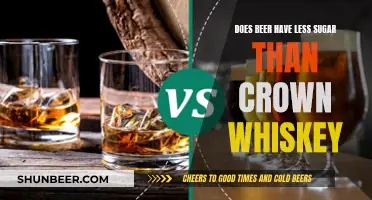
Ginger beer is a popular drink with a strong and spicy kick, but it often contains a surprising amount of sugar. In fact, research has shown that two-thirds of ginger beer drinks contain more sugar than a can of Coca-Cola. So, why does ginger beer have so much sugar? Well, it's down to the brewing process. Ginger beer is brewed with natural ginger, lemon juice, sugar, and is fermented with a ginger beer plant culture, mainly Lactobacillus. The sugar is not just added for sweetness; ginger's low natural sugar content means added sugar is necessary for the fermentation process.
What You'll Learn

Ginger beer's sugar content and health implications
Ginger beer is a popular drink with a strong ginger flavour and a unique brewing process. However, it has come under scrutiny for its high sugar content and potential health implications.
Sugar Content
Ginger beer is a fermented beverage, traditionally brewed with sugar, ginger, water, and sometimes lemon. This process results in a higher sugar content compared to other drinks. On average, a 12-fluid ounce serving of ginger beer contains 35 grams of sugar, which is significantly higher than the recommended daily limit of 6 to 9 teaspoons (24-36 grams) of added sugar for women and men, respectively, according to the American Heart Association.
To put this into perspective, a single can of Old Jamaica Ginger Beer, a popular brand in the UK, contains approximately 52.8 grams of sugar, which is more than 13 teaspoons. This amount far exceeds the recommended daily limit and is higher than the sugar content in a can of Coca-Cola.
Health Implications
The high sugar content in ginger beer has raised concerns about its potential impact on health. Excessive sugar consumption is linked to weight gain, which can increase the risk of heart disease. According to the World Health Organization, consuming more than 6 teaspoons of sugar per day is already considered excessive and can have negative health effects.
Additionally, the high sugar content in ginger beer can contribute to tooth decay. Professor Graham MacGregor, a specialist in cardiovascular medicine, has stated that added sugars are "completely unnecessary" and can lead to obesity, diabetes, and dental issues.
Reducing Sugar Intake
It is important to note that ginger beer is not the only sugary drink on the market, and consumers should be mindful of their overall sugar intake. Action on Sugar, a campaign group, has advocated for reducing sugar levels in such drinks, suggesting that manufacturers can significantly lower sugar content without compromising taste.
While ginger beer may have some health benefits due to the presence of ginger, the excessive sugar content can negate these potential benefits. Therefore, it is recommended to consume ginger beer occasionally rather than making it a regular part of your diet.
Rice vs Corn Beer: Which Has Less Sugar?
You may want to see also

The fermentation process
Ginger beer is made through a fermentation process that involves preparing a "ginger bug" or "ginger starter". This starter is made by combining fresh ginger, water, and sugar, and allowing it to sit for 24 hours. During this time, natural yeasts and probiotics in the ginger are activated and begin to reproduce. The starter is then fed daily with additional sugar and ginger for several days until it becomes bubbly, indicating that it is ready for use.
To make the ginger beer, the ginger starter is combined with a larger volume of water, sugar, lemon juice, and grated ginger. This mixture is allowed to ferment for about a week, during which time the natural yeasts and probiotics feed on the sugar, producing carbonation and a small amount of alcohol. The beverage is then bottled and allowed to undergo secondary fermentation for a few more days, resulting in a fizzy, probiotic-rich drink.
Priming Sugar for Beer: How Much is Too Much?
You may want to see also

Ginger beer vs ginger ale
Ginger beer and ginger ale are both fizzy drinks with a ginger flavour, but they have some important differences.
Origins
Ginger beer is believed to have originated in the United Kingdom in the 18th century, although some sources say it dates back to the 1800s. Early versions of the drink were fermented and contained alcohol, with some iterations reaching 11% ABV.
Ginger ale is a more recent invention, with the first version of the drink created by Detroit-based pharmacist James Vernor in 1866. Vernor's Ginger Ale is now one of the oldest soft drinks in America.
Ingredients and Flavour
Ginger beer is typically brewed using real ginger, giving it a stronger, spicier flavour than ginger ale. It is traditionally made effervescent through fermentation, although some modern versions use forced carbonation.
Ginger ale is often made by adding ginger syrup to carbonated water, resulting in a sweeter, more delicate flavour. It is usually artificially carbonated and rarely contains capsaicin.
Alcohol Content
Ginger beer may contain small amounts of alcohol (up to 0.5%) from the fermentation process.
Ginger ale is typically non-alcoholic.
Calories and Sugar
A 12-ounce serving of ginger ale contains 124 calories and 32 grams of sugar. The same amount of ginger beer contains about 114 calories and 40 grams of sugar.
Health Benefits
Both drinks contain real ginger root, which has anti-inflammatory compounds and can help reduce or prevent inflammation. It may also help ease motion sickness, morning sickness, and general nausea.
Cocktails
Ginger beer is commonly used in cocktails such as the Moscow Mule and Dark and Stormy.
Ginger ale is often used in non-alcoholic cocktails and highballs, such as a Pimm's Cup or Presbyterian.
Sugar in Beer: How Many Teaspoons?
You may want to see also

The role of sugar in fermentation
Fermentation is a process of central metabolism in which an organism converts a carbohydrate, such as starch or sugar, into an alcohol or an acid. In the context of ginger beer, fermentation is the process of converting sugar into alcohol through the use of yeast.
The production of carbon dioxide is a crucial aspect of fermentation, as it contributes to the carbonation and desired fizziness of ginger beer. The trapped carbon dioxide also helps to create the characteristic head or foam that forms when ginger beer is poured into a glass. Additionally, the carbon dioxide, along with ethanol, plays a role in increasing the volume of the beverage.
The type and amount of sugar used in ginger beer fermentation can impact the flavour and acidity of the final product. Different types of sugar, such as raw cane sugar or highly processed table sugar, may result in variations in the taste profile. The amount of sugar can also influence the level of acidity, with higher sugar concentrations potentially leading to a more acidic brew.
Furthermore, sugar plays a role in regulating the fermentation process. Higher sugar concentrations can create osmotic stress for the yeast, slowing down their activity and reducing the rate of carbon dioxide production. This, in turn, can affect the overall fermentation time and the final alcohol content of the ginger beer.
In summary, sugar is integral to the fermentation process in ginger beer. It serves as a food source for the yeast, influences flavour and acidity, and regulates the fermentation dynamics, ultimately contributing to the unique characteristics of the final beverage.
Beer and Blood Sugar: What's the Connection?
You may want to see also

Ginger beer's history
Ginger beer was first created in Yorkshire, England, in the mid-1700s during the colonial spice trade. It was initially made by fermenting and brewing sugar, ginger, water, and sometimes lemon and/or cream of tartar. The drink was then strained, and a portion of the old batch was used to make a new one.
The name "ginger beer" is misleading, as it was never actually a beer. Instead, the production methods were similar, and the drink was brewed and fermented. Ginger beer was, in many ways, a product of necessity, as people relied on the bacteria-killing alcohol levels to combat the general lack of safe drinking water. The addition of ginger provided a mild, pleasant spiciness that made the drink more palatable.
Ginger beer was a popular drink in Britain and North America from the 18th century until Prohibition. England shipped large amounts of ginger beer to the U.S. and Canada beginning in the 1790s through the 19th century and maintained market dominance due to its superior-quality stoneware bottles, which kept the drink effervescent and cold.
In the mid-19th century, most ginger beer brewers reduced the alcohol content in their products by lessening fermentation time, as British Parliament had imposed export taxes on beverages with an alcohol content above 2%.
Sugar Secrets: Coors Beer's Sweet Surprise
You may want to see also
Frequently asked questions
Ginger beer is a sweet-tasting drink with a strong ginger flavour. The sugar is added to complete the fermentation process, as ginger's natural sugar content is too low to do so.
The UK's most popular brand of ginger beer, Old Jamaica Ginger Beer, has 52.8g of sugar in a 330ml can. That's more than 13 teaspoons of sugar and over 60% more than a can of Coca-Cola.
Ginger is a healthy root with anti-inflammatory compounds. It can help to reduce or prevent inflammation and may also help with nausea, motion sickness, morning sickness, and general stomach troubles.







